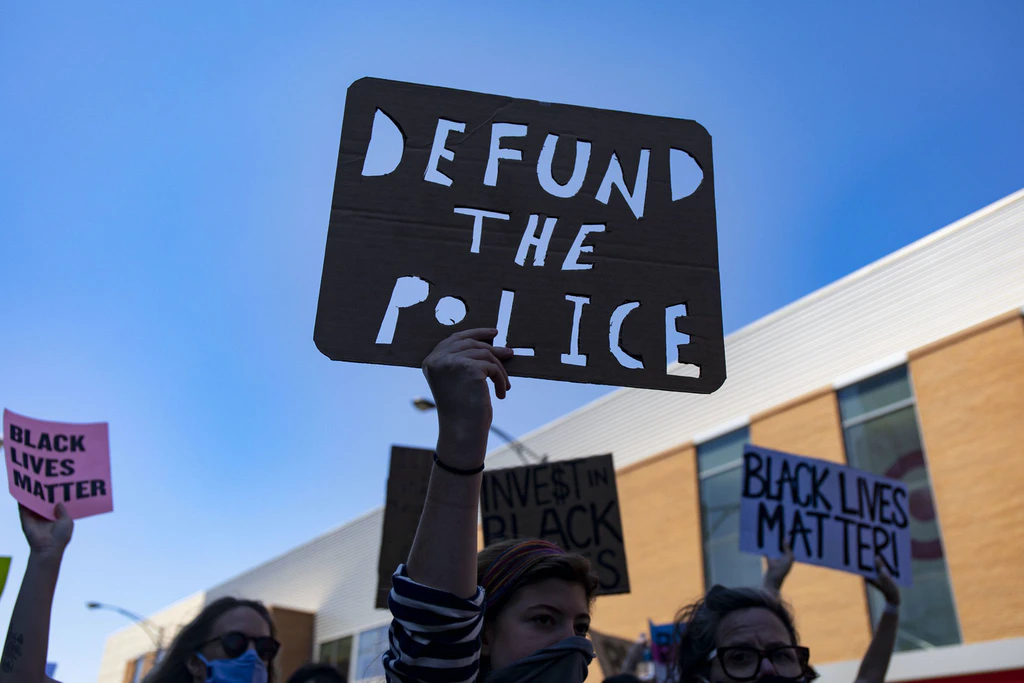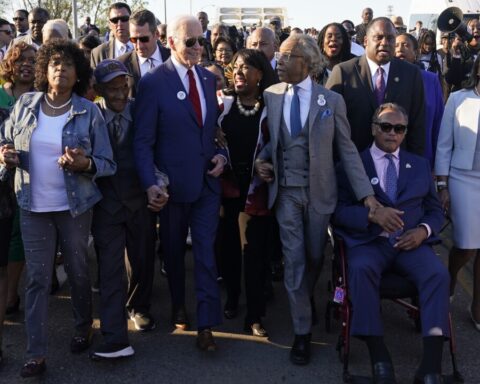Community organizers focused on eliminating police violence say they are disappointed by President Joe Biden’s proposed budget announced this week, which would allocate at least $30 billion in new police spending.
Biden opposed calls to “defund the police” since the movement began to build broader support in 2020. He reiterated his stance in his recent State of the Union address, declaring, “We should all agree: The answer is not to defund the police. The answer is to fund the police.”
So although the increased police funding in the fiscal year 2023 budget proposal comes as no shock to anti-police violence organizers, they say it is an insult to the communities that routinely face police violence.
“He’s trying to convey that he’s tough on law and order, that he’s supporting policing, which is a slap in the face and a complete disregard for the people who are organizing on the ground, primarily people who have a history of being brutalized by police and continue to be so,” said Charisse Burden-Stelly, assistant professor of Africana studies and political science at Carleton College, and the co-leader of research and political education for the Black Alliance for Peace, a nonprofit human rights organization.
The White House proposed about $30 billion to support state and local law enforcement agencies in preventing crime and for community violence intervention. Another $367 million is intended for the Department of Justice to prosecute hate crimes, protect voting rights and support police reform, an increase of $101 million from the current budget.
Preventing violent crime seemed to be the focus of the proposed police spending as federal data have, in recent years, pointed to a rise in homicides and other violent crimes across the country.
The answer is to “fund our police and give them all the tools they need: training, and foundation, and partners and protectors that our communities need,” Biden said when announcing the proposal.
Fighting violent crime has been a consistent justification for both Democrats and Republicans alike to bolster police funding at various levels of government. But some experts have long questioned whether adding more police actually reduces violent crime, and have instead suggested other anti-crime measures — such as expanding social and economic services — would be more effective. Meanwhile, police spending has mostly increased each year since a federal crime bill passed in 1994, even when crime rates dropped overall, according to Politico.
“We have to make clear to elected officials what safety looks like for us,” said Amara Enyia, policy and research coordinator for the Movement for Black Lives. “We don’t define safety by the number of police on our streets; we define safety by our ability to have housing, to have access to health care, and our ability to support ourselves and our families with gainful employment. So the investments that we push for go into supporting those things.”
The new budget comes as the dust continues to settle following 2020’s summer of George Floyd protests and the international racial reckoning that followed. Amid the protests, boycotts and calls to defund the police, local governments across the country vowed to do just that and prioritize social services with the money. However, a year later, it was revealed that several departments restored the funding, allocated even more money to police departments, or never made the promised cuts at all.
Politicians across the political spectrum have dismissed the movement to defund the police as unpopular and ineffective. But the movement hasn’t been without effect. In November, 44 percent of Minneapolis voters supported replacing the city’s embattled police department with a department of public safety. The measure ultimately failed, but organizers said the support marked a turning point in the fight against police violence.
“We have pushed not just the city of Minneapolis, but the entire country to talk about public safety in a way that it should be talked about, which is not just police,” JaNaé Bates, communications director of Yes 4 Minneapolis, one of the grassroots groups that spearheaded the amendment, told NBC News at that time.
Efforts in other cities provided more encouragement for anti-police violence advocates. In Austin, Texas, voters rejected a measure to hire more police officers, and in Des Moines, Iowa, a Black Lives Matter activist who ran on a “defund” platform beat a two-term incumbent for a seat on the city council.
States and police departments across the country have padded police budgets and launched plans to build new prisons using funding intended for pandemic aid from the American Rescue Plan Act, the $1.9 trillion stimulus package Biden passed shortly after taking office. Organizers and activists called giving stimulus funds to police departments “highly offensive,” but the criticism has not seemed to sway Biden.
He told New York City Mayor Eric Adams at a meeting in February that he wants even more cities and states to use American Rescue Plan Act funding “to keep our communities safe by hiring more police officers for community policing and paying police overtime, and purchasing gun-fighting technologies.”
Amid talk of boosting police budgets to promote safety, police violence has steadily risen over the last few decades, according to a study published in the peer-reviewed journal The Lancet. Despite any social advancements made from the 2020 protests, recent data collected by The Washington Post show that the number of Black people killed by police has increased over the last two years. And bipartisan efforts at police reform have repeatedly failed.
Although many Republicans have already denounced Biden’s proposed budget, organizers are prepared to continue their fight for communities without police and, therefore, police violence, they say.
“The question we have to ask is, ‘What’s actually being proposed that’s different from the failed strategies that haven’t worked?’” Enyia said. “This budget tells us there isn’t much that’s different, which is disappointing … It’s clear that this administration is doubling down on the same strategies and tactics that have not worked in the past. We have to work even harder to continue to push our message, which came out of communities, about what safety actually looks like and requires.”





